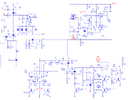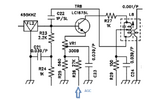Found a few of these informative videos that are worth a watch to the 955 v1 or v2 owners. It debunks some things that some use to lure people in and some is just good to know.
You are using an out of date browser. It may not display this or other websites correctly.
You should upgrade or use an alternative browser.
You should upgrade or use an alternative browser.
-
You can now help support WorldwideDX when you shop on Amazon at no additional cost to you! Simply follow this Shop on Amazon link first and a portion of any purchase is sent to WorldwideDX to help with site costs.
Stryker SR-955hpc to do or not to do
- Thread starter Eldorado828
- Start date
-
- Tags
- mods stryker stryker sr-955hpc
Greg T
WDX-945 (Jazz Singer) Upper Peninsula of Michigan
Wrong Mark lol this Mark been working with the Chinese for a while on these radios
Next you'll want evidence to back up outrageous claims. Where does it end?Yep this is the good Mark, the one with facts.
Although I don't understand everything, I've been competent and alive long enough to know when I see smoke and mirrors. It's been nice to see Mark release these videos not only to debunk some of the myths but also showing how and why. It's a pretty clear picture of reality vs what one makes claims of.Next you'll want evidence to back up outrageous claims. Where does it end?
Main reason for sharing the video is so that newcomers into the hobby might run into this thread before getting hosed.
I think we all know where these claims come from and we can't have an innocent person falling for the false cb gospel.
Here's the "area" talked about in the top vid with Mike referring to the 220K replaced with a 33K - and the AGC area he talks about with that distortion figure.
It's just the Schematic, but the 220K you can easily see why its value is needed there - 33K doesn't do anything to help the AGC develop any power to trim down the RF signal - Mike does a good demonstration of this in the Vid.
I had time to look into it today...

I neglected to show that part of the circuit that - if you look into the Cobras - like the 148GTL even the 2000 - you might see Q4 in the above - in a different way...
Some of you may be wondering if this is a familiar sight - or at least you've seen it before...
Yes, you have...
It's just the Schematic, but the 220K you can easily see why its value is needed there - 33K doesn't do anything to help the AGC develop any power to trim down the RF signal - Mike does a good demonstration of this in the Vid.
I had time to look into it today...

I neglected to show that part of the circuit that - if you look into the Cobras - like the 148GTL even the 2000 - you might see Q4 in the above - in a different way...
Some of you may be wondering if this is a familiar sight - or at least you've seen it before...
Yes, you have...
Last edited:
Had an idea a while back, been waiting for someone else to work it out. Rotary encoders come in two basic varieties. Quadrature and absolute.
Only kind I ever designed with is the absolute type. A two bit binary code called "Gray code". It's a steady pair of binary one and zero. Holds steady and changes only when turned one whole "click" or detent. A quadrature type is what I keep seeing in radios as a channel selector. It closes two contact points each click, but only while the shaft is between detent positions. Both contacts are open when at rest in the detent. Has two contacts. The controller can tell the direction it was turned by which one of the two outputs closes first. The problem with this kind of encoder is bounce. Turn it too fast and the contact points will make and break more than just once per click. Makes the radio jump multiple channels. Turn some of them fast enough and the channels will change in the wrong direction.
Once I got the program code ironed out to use a gray-code encoder I could spin it pretty fast before it got confused.
The idea was to take the tiniest version of the PIC chip, move my program for the gray-code encoder into it. Then add instructions so it puts out the quadrature sequence that a commercial radio is expecting. But with the logic output of the chip. No contact bounce.
Figured the likeliest market for it would be the "black" base radios with 2950 type radios inside them. Never did find anyone to sell me the a gray-code encoder with a split 6mm shaft.
Still waiting for someone to beat me to it.
73
Only kind I ever designed with is the absolute type. A two bit binary code called "Gray code". It's a steady pair of binary one and zero. Holds steady and changes only when turned one whole "click" or detent. A quadrature type is what I keep seeing in radios as a channel selector. It closes two contact points each click, but only while the shaft is between detent positions. Both contacts are open when at rest in the detent. Has two contacts. The controller can tell the direction it was turned by which one of the two outputs closes first. The problem with this kind of encoder is bounce. Turn it too fast and the contact points will make and break more than just once per click. Makes the radio jump multiple channels. Turn some of them fast enough and the channels will change in the wrong direction.
Once I got the program code ironed out to use a gray-code encoder I could spin it pretty fast before it got confused.
The idea was to take the tiniest version of the PIC chip, move my program for the gray-code encoder into it. Then add instructions so it puts out the quadrature sequence that a commercial radio is expecting. But with the logic output of the chip. No contact bounce.
Figured the likeliest market for it would be the "black" base radios with 2950 type radios inside them. Never did find anyone to sell me the a gray-code encoder with a split 6mm shaft.
Still waiting for someone to beat me to it.
73
dxChat
- No one is chatting at the moment.
-
@ Wildcat27:Hello I have a old school 2950 receives great on all modes and transmits great on AM but no transmit on SSB. Does anyone have any idea?
-
-
-
dxBot:63Sprint has left the room.
-
dxBot:kennyjames 0151 has left the room.

